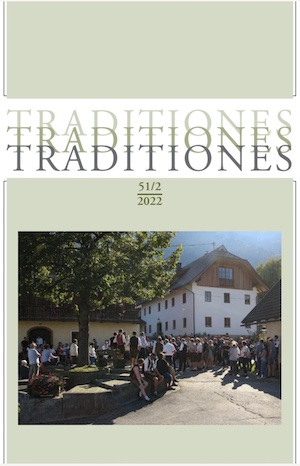»Un bel moretto«: Jezikovna prepletanja v pesmih s Primorskega
DOI:
https://doi.org/10.3986/Traditio2022510203Ključne besede:
dvojezične pesmi, Goriška brda, Beneška Slovenija, Istra, godci, splošno razširjene melodijePovzetek
»Lan sem biu u Gorici« je najpogosteje zapisana dvojezična pesem, v kateri se prepletata slovensko in italijansko narečno besedilo. V nasprotju z variantami iz Goriških brd in Beneške Slovenije, kjer je pesem večinoma pozabljena, doživljajo istrske variante preporod in so označene kot tipično istrske. Članek sledi meandrom prehodov med različnimi jezikovnimi različicami in lokalnimi prilastitvami te pesmi.
Prenosi
Literatura
Ben-Amos, Dan. 1975 (1972). Toward a Definition of Folklore in Context. In Toward New Perspectives in Folklore, eds. Americo Paredes and Richard Bauman, 3–15. Austin, London: University of Texas Press.
Brambilla, C. 2015. Exploring the Critical Potential of the Borderscapes Concept. Geopolitics 20 (1): 14–34. DOI: https://doi.org/10.1080/14650045.2014.884561.
Brusila, Johannes. 2015. Why do Songs have Words in Different Languages?: Negotiating Minority Identity through Language Choice among Swedish-Speaking Musicians in Finland. In Speaking in Tongues, eds. Dietrich Helms and Thomas Phleps, 9–32. Bielefeld: transcript Verlag. DOI: https://doi.org/10.14361/9783839432242-002.
D’Aronco, Gianfranco, and Milko Matičetov. 1950–1951. Folklorna anketa v Furlaniji 1946. Slovenski etnograf 3/4: 297–330. https://www.etno-muzej.si/sl/etnolog/slovenski-etnograf-34-1951/folklorna-anketa-v-furlaniji-1946.
Feichtinger, Johannes, and Gary B. Cohen, eds. 2014. Understanding Multiculturalism: The Habsburg Central European Experience. New York: Berghahn.
Frith, Simon. 1987. Why Do Songs Have Words? In Lost in Music: Culture, Style and the Musical Event, ed. Avron Levine White, 77–106. London: Routledge & Kegan Paul.
Hafstein, Valdimar Tr. 2018. Intangible Heritage as Festival: Or, Folklorization Revisited. Journal of American Folklore 131 (520): 127–149. DOI: https://doi.org/10.5406/jamerfolk.131.520.0127.
John, Eckhard. 2015. Zweisprachige Songs: Sprachmuster transkultureller Inszenierungen. In Speaking in Tongues, eds. Dietrich Helms and Thomas Phleps, 157–176. Bielefeld: transcript Verlag.
Juvančič, Katarina. 2005. The Popularization of Slovenian Folk Music between the Local and Global: Redemption or Downfall of National Heritage. Traditiones 34 (1): 209–219. DOI: https://doi.org/10.3986/Traditio2005340117.
Juvančič, Katarina. 2013. Muzika za luzerje brez pasuša. https://www.sigic.si/muzika-za-luzerje-brez-pasusa.html.
Klobčar, Marija. 2010. Zvrstnost slovenskih ljudskih pesmi: Refleksija pesemskega razvoja ali pogledov nanj. Traditiones 39 (2): 124–145. DOI: https://doi.org/10.3986/Traditio2010390208.
Klobčar, Marija. 2012. Prva svetovna vojna in slovenske ljudske vojaške pesmi. In Vojne na Slovenskem: Pričevanja, spomini, podobe, ed. Maja Godina Golija, 27–46. Ljubljana: Založba ZRC, ZRC SAZU, 27–46. DOI: https://doi.org/10.3986/9789610503415.
Klobčar, Marija. 2020. The Perception of Bilingual Songs in Slovenia and the Cultural Dimensions of Language Selection. Tautosakos darbai 59, 209–228. http://www.llti.lt/failai/TD59_spaudai_internetine%20versija-193-212.pdf.
Koštial, Rožana. 1996. Ljudske iz Šavrinske Istre: Ćiv, ćiv, ćiv, sen miken, ma sen živ. Trst: Devin editoriale.
Kovačič, Mojca. 2012. In Search of the ‘Folk Character’ We Would Like to Hear: The Dichotomy Between Folk, the Profession, and Scholarship. Traditiones 41 (1): 77–90. DOI: https://doi.org/10.3986/Traditio2012410107
Kozorog, Miha. 2014. Etnološki in antropološki pogledi na javne prireditve v Sloveniji. Etnolog 24: 23–42. https://www.etno-muzej.si/files/etnolog/pdf/etnolog_24_kozorog_etnoloski.pdf.
Kranjac, Marino. 2022. Personal correspondence.
Laarse, Rob van der. 2019. Europe’s Peat Fire: Intangible Heritage and the Crusades for Identity. In Dissonant Heritages and Memories in Contemporary Europe, eds. Tuuli Lähdesmäki et al., 79–134. Cham: Palgrave Macmillan. DOI: https://doi.org/10.1007/978-3-030-11464-0.
Lukač, Klavdija. 2018. S pesmijo in golido do šturka. Diplomska naloga. Koper: UP PEF.
Makor, Andrej. 2009. Istrska reštica: Cikel istrskih ljudskih za mešani zbor. Tržič: Astrum.
Marty, Maša. 2004. Iz arhiva Glasbenonarodopisnega inštituta o prvem etnomuzikološkem raziskovanju v severovzhodni Istri. Traditiones 33 (2): 193–206. DOI: https://doi.org/10.3986/Traditio2004330209.
Marušić, Dario. (Forthcoming). Oj divojko, ča si tako lipa. In Gajba i tić: Ljubav i spolnost u Istri, ed. Milena Joksimović. Pula: PPMI/AMI.Merkù, Pavle, 2004. Ljudsko izročilo Slovencev v Italiji: Zbrano v letih 1965–1974 = Le tradizioni popolari degli Sloveni in Italia: raccolte negli anni 1965–1974. Udine: Pizzicato.
Paredes, Americo, and Richard Bauman, eds. 1975 (1972): Toward New Perspectives in Folklore. Austin, London: University of Texas Press.
Pettenati, Giacomo, ed. 2023. Landscape as Heritage: International Critical Perspectives. London, New York: Routledge.
Pisk, Marjeta. 2008. Raziskave ljudske pesmi: med tekstom in kontekstom. Traditiones 37 (1): 99–111. DOI: https://doi.org/10.3986/Traditio2008370105.
Pisk, Marjeta. 2012. Nacionalizacija ljudske pesemske tradicije Goriških brd = Nationalizing the folksong tradition of Goriška brda. In Prostor v literaturi in literatura v prostoru = Space in literature and literature in space 60 (3): 483–498, 499–515. Ljubljana: Slavistično društvo Slovenije. http://www.srl.si/sql_pdf/SRL_2012_3_17.pdf, http://www.srl.si/sql_pdf/SRL_2012_3_18.pdf.
Pisk, Marjeta. 2013. Ponovno o oblikovanju in razvoju glasbene folkloristike. Traditiones 42 (1): 109–123. DOI: https://doi.org/10.3986/Traditio2013420106.
Pisk, Marjeta, and Špela Ledinek Lozej. 2023. Cross-Border Landscape as Heritage?: Insights from Slovenian Borderlands. In Landscape as Heritage: International Critical Perspectives, ed. Giacomo Pettenati, 136–147. London, New York: Routledge. DOI: https://doi.org/10.4324/9781003195238.
Saksida, Aljoša. 2021. Zapojmo z našimi dedi ljudska in narodna pesem v Furlaniji Julijski krajini. Trst: Kru.t.
Steccati, Renata. 1932. Canti popolari Sloveni in Friuli. Rivista di letterature slave 5–6: 307–325.
Šivic, Urša. 2016. The Influence of Institutionalized Standards on the Transformation of Traditional Singing. Translingual Discourse in Ethnomusicology 2: 63–81. https://www.tde-journal.org/index.php/tde/article/download/1886/1710.
Špeh, Rožana. 1999. Šupeter je na lepa vas: Zbirka ljudskih pesmi iz Slovenske Istre. Ljubljana: Založba Kres.
Taylor, Timothy D. 2015. World Music, Value, and Memory. In Speaking in Tongues, eds. Dietrich Helms and Thomas Phleps, 103–118. Bielefeld: transcript Verlag. DOI: https://doi.org/10.14361/9783839432242-007.
Ther, P. 2003. Sprachliche, kulturelle und ethnische „Zwischenräume“ als Zugang zu einer transnationalen Geschichte Europas. In Regionale Bewegungen und Regionalismen in europäischen Zwischenräumen seit der Mitte des 19. Jahrhunderts, eds. Philipp Ther and Holm Sundhaussen, IX–XXIX. Marburg: Herder-Institut.
Trudgill, Peter. 1983. On Dialect: Social and Geographical Perspectives. Oxford: Basil Blackwell.
Vodušek, Valens. 1969. Razmerje med besedilom in napevom v ljudski pesmi. Jezik in slovstvo 14 (1): 1–6.
Vodušek, Valens. 2003. Etnomuzikološki članki in razprave. Ljubljana: Založba ZRC, ZRC SAZU.
Prenosi
Objavljeno
Kako citirati
Številka
Rubrike
Licenca

To delo je licencirano pod Creative Commons Priznanje avtorstva-Nekomercialno-Brez predelav 4.0 mednarodno licenco.
Avtorji jamčijo, da je delo njihova avtorska stvaritev, da v njem niso kršene avtorske pravice tretjih oseb ali kake druge pravice. V primeru zahtevkov tretjih oseb se avtorji zavezujejo, da bodo varovali interese založnika ter da bodo povrnili morebitno škodo.
Podrobneje v rubriki: Prispevki






